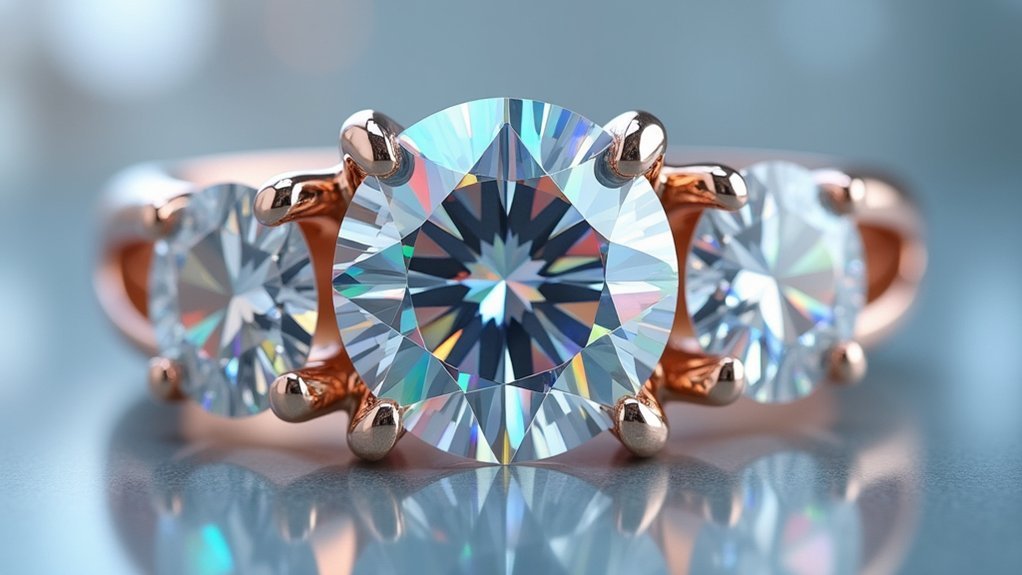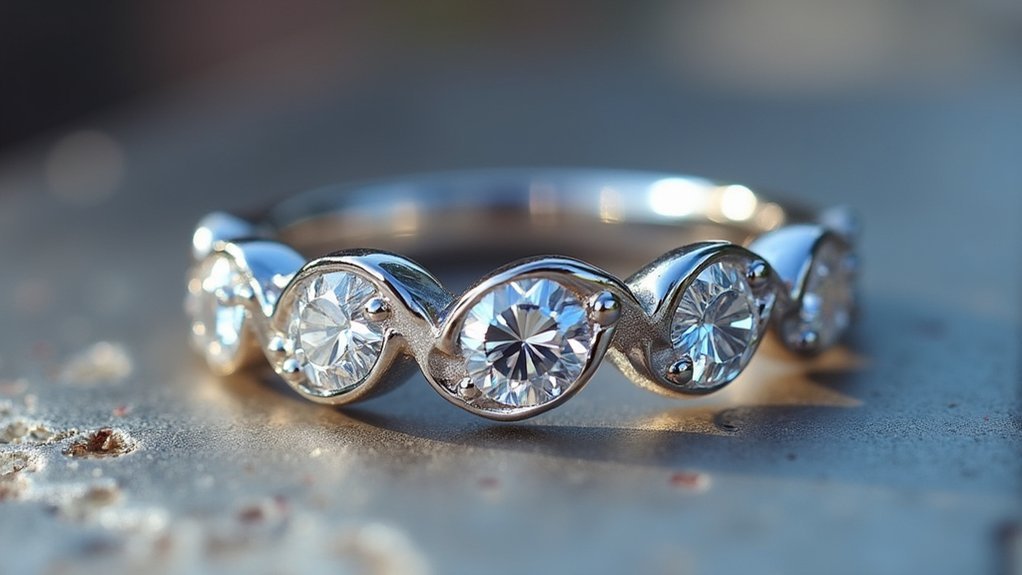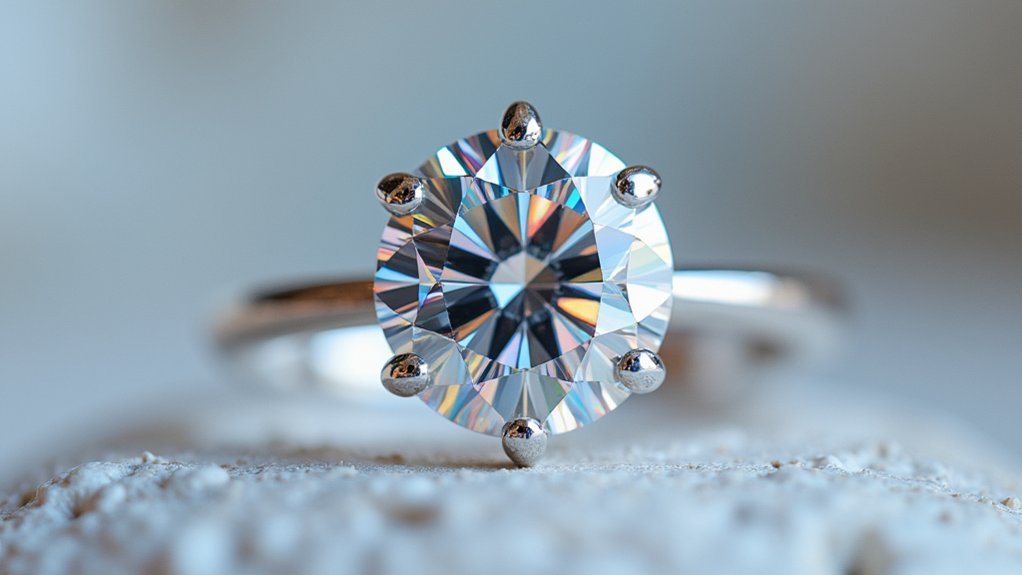Fishtail diamond settings feature distinctive prongs that flare outward like actual fishtails, creating an elegant French pavé style that holds your diamonds low in the metal. You’ll find this technique maximizes light entry from multiple angles, enhancing your stones’ sparkle and brilliance while providing exceptional security that prevents loosening. The understated aesthetic combines traditional craftsmanship with innovative artistry, making it perfect for engagement rings, wedding bands, and eternity pieces. Discover why discerning collectors prefer this sophisticated mounting method.
Understanding the Fishtail Diamond Setting Design

While many jewelry enthusiasts recognize popular settings like prong or bezel, the fishtail diamond setting remains one of jewelry’s best-kept secrets.
Also called French pavé, this fishtail setting features distinctive prongs that flare outward like fishtails, creating an elegant and functional design.
You’ll notice how this secure setting holds diamonds low in the metal while allowing maximum light entry. The flared prongs don’t just provide stability—they enhance your stones’ sparkle by permitting light to reach the diamonds from multiple angles.
The fishtail setting’s flared prongs maximize light exposure while securing diamonds low in the metal for enhanced brilliance.
This meticulous craftsmanship combines techniques from both castle and pavé settings, resulting in understated grandeur.
The design’s sophisticated aesthetic makes it particularly effective for showcasing smaller stones, where traditional settings might overwhelm the gems’ natural beauty.
How Fishtail Settings Compare to Traditional Prong and Bezel Settings
When you’re choosing between diamond settings, understanding how fishtail compares to traditional options reveals significant differences in both aesthetics and functionality. Fishtail settings feature unique tapered prongs that split elegantly, resembling fishtails, while traditional prong settings use simple small prongs with minimal metal visibility. Unlike bezel settings that fully encase diamonds, fishtail settings allow significant light entry for enhanced sparkle while maintaining security.
| Feature | Fishtail Settings | Traditional Prong | Bezel Settings |
|---|---|---|---|
| Light Entry | High sparkle enhancement | Maximum light exposure | Reduced due to encasement |
| Metal Visibility | Understated elegance | Minimal prong visibility | Pronounced metal frame |
| Security Level | Balanced protection | Basic holding power | Maximum stone security |
| Recognition | Largely unrecognized | Widely recognized | Standard option |
You’ll find fishtail settings offer sophisticated craftsmanship appealing to jewelry connoisseurs seeking subtle grandeur.
The Technical Process of Creating Fishtail Diamond Settings

Behind every sophisticated fishtail diamond setting lies an intricate technical process that demands exceptional precision and expertise.
You’ll start by drilling tapered holes along the metal band, creating the foundation for your continuous stone row. Next, you’ll grind notches and saw between these holes to form individual stone seats that guarantee snug diamond placement.
The setting process requires using a setting bur for pilot holes, while stones under 2mm need a small ball bur. You must achieve correct seat depth for proper alignment.
Once positioned, you’ll add decorative fishtail-style engravings to enhance the aesthetic appeal. Finally, you’ll complete the setting through bright-cutting and pushing metal over the stones, securing them while maintaining the elegant fishtail appearance.
Advantages and Security Features of Fishtail Mounting
Since fishtail diamond settings utilize two small secure beads and pushed-over metal sections, they hold diamonds remarkably low in the mounting while delivering exceptional stone security.
This innovative approach creates multiple advantages that make fishtail settings increasingly popular among jewelry enthusiasts.
The security features of fishtail mounting provide these key benefits:
- Enhanced stone stability – The low-profile design prevents diamonds from loosening or falling out compared to traditional prong settings
- Maximum light entry – The setting’s structure allows significant light penetration, boosting diamond sparkle and brilliance
- Snag-resistant profile – The snug mounting reduces catching on clothing, making it ideal for everyday wear
- Elegant aesthetics – The fishtail-resembling side profile combines sophisticated appearance with practical functionality
You’ll find that this fishtail setting offers superior protection while maintaining the refined look you want.
Popular Jewelry Pieces Using Fishtail Diamond Settings

While fishtail settings excel in security and brilliance, their versatility truly shines across diverse jewelry applications. You’ll find this diamond ring setting particularly stunning in engagement rings, where it combines larger center stones with smaller accent diamonds for maximum sparkle. Band rings showcase the fishtail setting’s ability to create continuous rows of brilliance with melee stones.
| Jewelry Type | Stone Configuration | Design Impact |
|---|---|---|
| Engagement Rings | Center + accent stones | Enhanced sparkle |
| Wedding Bands | Continuous melee | Uniform brilliance |
| Eternity Bands | Equal-sized diamonds | Seamless flow |
| Anniversary Rings | Mixed stone sizes | Dynamic contrast |
| Fashion Rings | Contemporary layouts | Modern elegance |
Contemporary jewelry collections increasingly feature fishtail settings, reflecting meticulous craftsmanship that appeals to those appreciating understated beauty and superior artistry.
Tools and Techniques Required for Fishtail Setting Craftsmanship
You’ll need specialized hand tools like setting burs, ball burs, and knife-edge gravers to execute fishtail settings with precision.
Your drilling and cutting methods must be exact since you’re creating pilot holes and V-shaped reliefs that determine the final appearance.
The stone setting process requires careful technique with brass pushers and flat gravers, as adjustments become nearly impossible once you’ve completed the setting.
Essential Hand Tools
Five fundamental hand tools form the backbone of professional fishtail diamond setting work.
You’ll need these specialized instruments to execute this intricate setting style with precision and consistency.
Your essential toolkit includes:
- Setting burs and ball burs – Setting burs drill accurate pilot holes, while small ball burs (recommended for stones under 2mm) create precise seats for small stones.
- Heart burs – Sized to match your stones, these create side relief cuts that enhance both design aesthetics and setting security.
- Knife-edge gravers – Essential for detailing cuts between side reliefs, adding finesse to your fishtail design.
- Brass pusher – Critical for securely inserting stones into their seats, ensuring a snug, professional fit.
Additionally, you’ll benefit from setting tools and a pendant motor for enhanced control during delicate operations.
Drilling and Cutting Methods
Three precise drilling and cutting techniques form the foundation of professional fishtail diamond setting work.
You’ll start by drilling tapered holes along your metal bar using a setting bur for pilot holes. For stones under 2 mm, switch to a small ball bur for better precision.
Cut your stone seats to 90% of the stone’s actual size, ensuring the tables sit level with your ring’s top surface. This creates the snug fit essential for secure stone setting.
Next, use a heart bur matching your stone size to create side relief cuts that enhance the fishtail’s distinctive detail.
Complete your work with a knife-edge graver for precise detail cuts between reliefs. Start these cuts one-third from the ring rail for ideal control and finish all adjustments before setting stones.
Stone Setting Process
Once your drilling and cutting work is complete, setting the stones requires specific tools and methodical execution to achieve professional results. The stone setting process demands precision since final adjustments become extremely difficult after placement.
You’ll need these essential tools for a beautiful setting:
- Brass pusher – Insert stones carefully into their prepared seats
- Flat graver – Widen V-shaped spaces to secure stones tightly
- Heart bur – Create necessary side relief cuts around each stone
- Knife-edge graver – Add detailed finishing touches between reliefs
Execute each step methodically, ensuring stones sit level with the ring’s top surface.
The tapered holes you’ve drilled must accommodate each stone securely while maintaining consistent alignment throughout the band for ideal visual appeal.
Why Fishtail Settings Appeal to Jewelry Connoisseurs
What draws discerning jewelry collectors to fishtail settings when countless other options exist?
You’ll find that fishtail settings offer a sophisticated alternative to flashier designs, appealing to your refined taste with their understated grandeur. The intricate craftsmanship often goes unnoticed by casual observers, making these settings a rare choice that speaks to your appreciation for detailed artistry.
When you choose fishtail settings, you’re selecting pieces that maximize light entry, ensuring your gemstones achieve brilliant sparkle.
The unique prong design resembles actual fishtails, providing both security and elegant aesthetics that enhance your jewelry’s overall beauty.
These settings masterfully combine castle and pavé techniques, showcasing traditional and innovative artistry that captivates serious jewelry enthusiasts like yourself.
Frequently Asked Questions
What Is a Fishtail Setting?
You’ll find a fishtail setting features prongs that flare and taper like fishtails, securing gemstones while allowing maximum light entry. It’s also called French pavé, combining elegance with exceptional sparkle enhancement.
What Are the Different Types of Diamond Settings?
You’ll find several diamond setting types including prong settings with metal claws, bezel settings that encircle stones, pavé settings with multiple small diamonds, tension settings using pressure, and fishtail settings with decorative prongs.
What Is a French Fishtail Setting?
You’ll find French fishtail settings feature prongs that flare outward like fish tails, combining castle and pavé elements. They’re perfect for showcasing smaller diamonds in bands, offering excellent light entry while maintaining security and elegance.
What Is Fishtail Pave?
You’ll find fishtail pavé combines flared, fishtail-shaped prongs with closely-set smaller stones, creating continuous sparkle. This setting maximizes light entry while providing security, offering you an elegant, sophisticated look that’s particularly popular in wedding bands.
In Summary
You’ll find that fishtail diamond settings offer you an exceptional blend of artistry and security for your precious stones. When you’re choosing between setting options, you’ll appreciate how the fishtail’s intricate metalwork showcases your diamond’s brilliance while providing superior protection. If you’re seeking a distinctive mounting that demonstrates masterful craftsmanship, you can’t go wrong with this sophisticated technique that’s captured the attention of discerning jewelry enthusiasts worldwide.





Leave a Reply